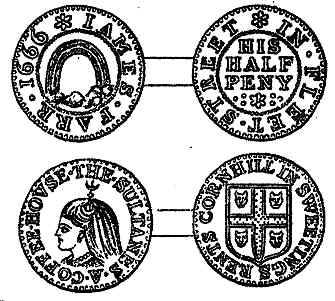London Numismatic Club Meeting, 3 October 2006
Robert Thompson spoke on `London Coffee-house tokens'.
Traditionally, the first English coffee-house was opened in Oxford in 1650, as stated by Anthony Wood. However, Wood did not make this claim until 1671, and in the earliest version of his diary he merely claimed that coffee was consumed in private in 1650. In London in 1651 Thomas Hodges, Grocer and Turkey merchant, welcomed into his house the young Draper and Levant merchant Daniel Edwards with the prospect of marrying Hodges' daughter. Edwards had returned from Izmir with his Greek manservant Pasqua Rosee, bringing the habits of Levantine merchants of hard work, Puritan politics, and coffee drinking. The novelty of coffee at Hodges' house impeded the family's work, so Edwards and his father-in-law set up Rosee in a stall in St Michael's churchyard to sell coffee to the public. This was the first coffee-house in Christendom.
Christopher Bowman, apprenticed to Hodges, became free of the Grocers in 1654. As such he was brought in as a partner for Rosee when local ale-sellers queried his right as a foreigner to trade in the City. Their partnership moved across St Michael's Alley to better premises in 1656. Bowman's coffee-house was a prodigious success until 1662.
After the Great Fire his coffee-house was run by George Backler and Stephen Hayward, whose undated halfpenny was issued At the ould Coffee house, formerly Bomans. The earliest dated coffee-house token is from the Solyman, Ivy Lane, in 1663. The 1666 token of James Farr at the Rainbow is another [Fig.]. In 1657 James Farr's building accommodated the bookseller Daniel Pakeman, and from 1663 to 1669 the . printer and bookseller Samuel Speed. His penny token of 1667, new to Williamson, appears in the forthcoming Norweb Tokens Part VII.
The most famous coffee-house keeper was Thomas Garraway, whose establishment flourished in Exchange Alley from 1668/70 until the late nineteenth century. It began in Sweeting's Rents by the Royal Exchange, where Thomas Garway and his wife Elizabeth were living by early 1658. Thomas appears from a notice in Mercurius Politicus to have been the first retailer of leaf tea in England `at the Sultanesshead, a Cophee-house'. Dr Kenneth Rogers drew support from this advertisement for his suggestion that Garraway was the issuer of this anonymous token:
Obv. THE SVLTANESS A COFFEE HOVSE around a female bust to left
Rev. IN SWEETINGS RENTS CORNHIL around arms [Fig.]
Dr Rogers' suggestion can be confirmed through identification of the arms as those of Garway otherwise Garraway.
